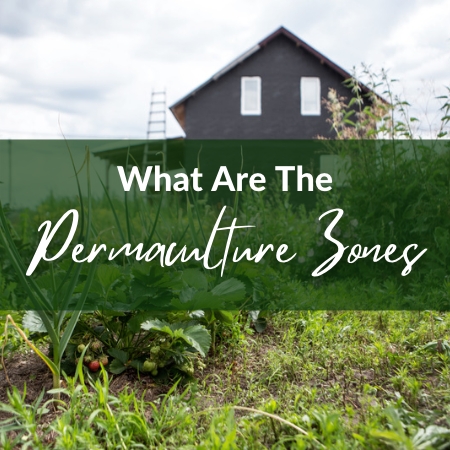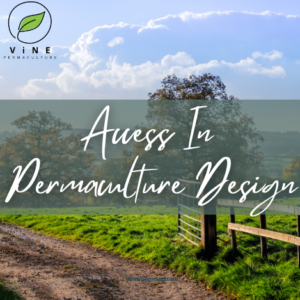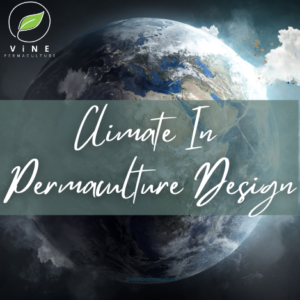There are five permaculture zones. These zones break down the property into the most used areas, to the least used areas. This helps to organize the space based on energy use and resource availability.
Permaculture Zones
Zone 0 – This is the home or main residence.
Zone 1 – This is the kitchen garden, chickens, and high-value plants.
Zone 2 – This is food forests, bees, and other perennial foods.
Zone 3 – This is the farm! It may include small or large livestock, ponds, and barns.
Zone 4 – This may be mushroom grow areas, foraging wild edibles, or woodlots.
Zone 5 – Wilderness.
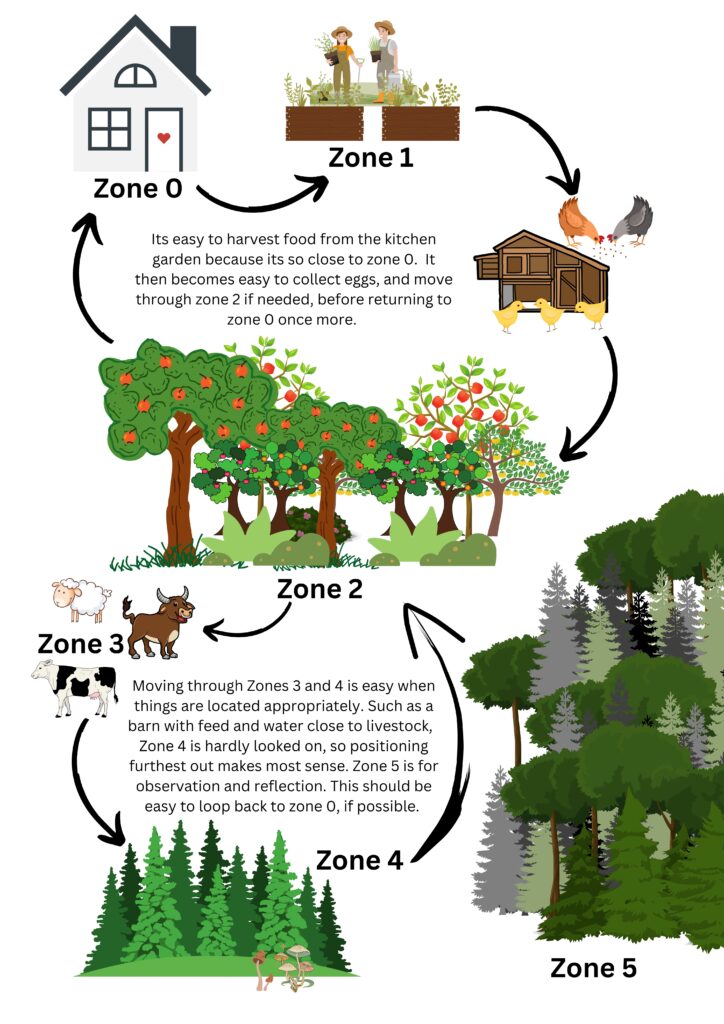
Zone 1
Zone 1 spaces usually consist of kitchen gardens, compost systems, small animals, water tanks, entertaining areas, and high-maintenance plants. The convenience of these to zone 0 is important because it saves time and energy when access is needed. The kitchen garden is also a great place to keep high-value plants, because of how frequently the area is used. Keeping things close means it’s quick to identify problems with pests and diseases.
Keeping compost close to the kitchen is also advisable. This is a great way to make sure kitchen scraps make it to the compost and not into the bin. Compost systems will vary, so it’s important to look at the different methods and see which will suit your space and needs best.
Finally, water harvested from the roof will be close to the house and stored in tanks. This makes watering the garden very convenient, especially if you are manually moving water from tanks to pots and plants. The shorter distance helps also with water pressure, and is a cost-saver!
Zone 2
Zone 2 is usually for perennial food crops, such as fruit trees, and berries. This may also be known as a food forest, or the home orchard. This system will look different depending on the slope of the land, wind, water flow, exposure, climate, and other environmental factors. Some people may use a steep slope tree planting method, or syntropic rows, while others may use a swale system. To understand how to plant a food forest, check out our blog here:
https://vinepermaculture.com/what-is-a-food-forest/
The important thing to remember is this area is visited regularly and produces a large number of seasonal foods. This area may also contain medicine gardens, bush tucker, native species, and bees. Gray water from zone 0 may be diverted to the orchard also, depending on local regulations and planting options.
Zone 3
Zone three is the farm. This is the barns, cash crops, animals, stocked ponds, livestock dams, rotational pastures, and laneways. This area of the property is not monitored extensively but is still visited at least weekly. This allows care for animals or crops, and regular maintenance. Keeping animals further from the house also reduces offensive odors and noises.
In zone 1 I mentioned the use of water tanks. This is not necessarily for zone 1 exclusively. Rainwater may be collected from the roof of barns and shelters and diverted to troughs or crops. This means being more resourceful and less wasteful. It’s also a great way to work smarter, and not harder!
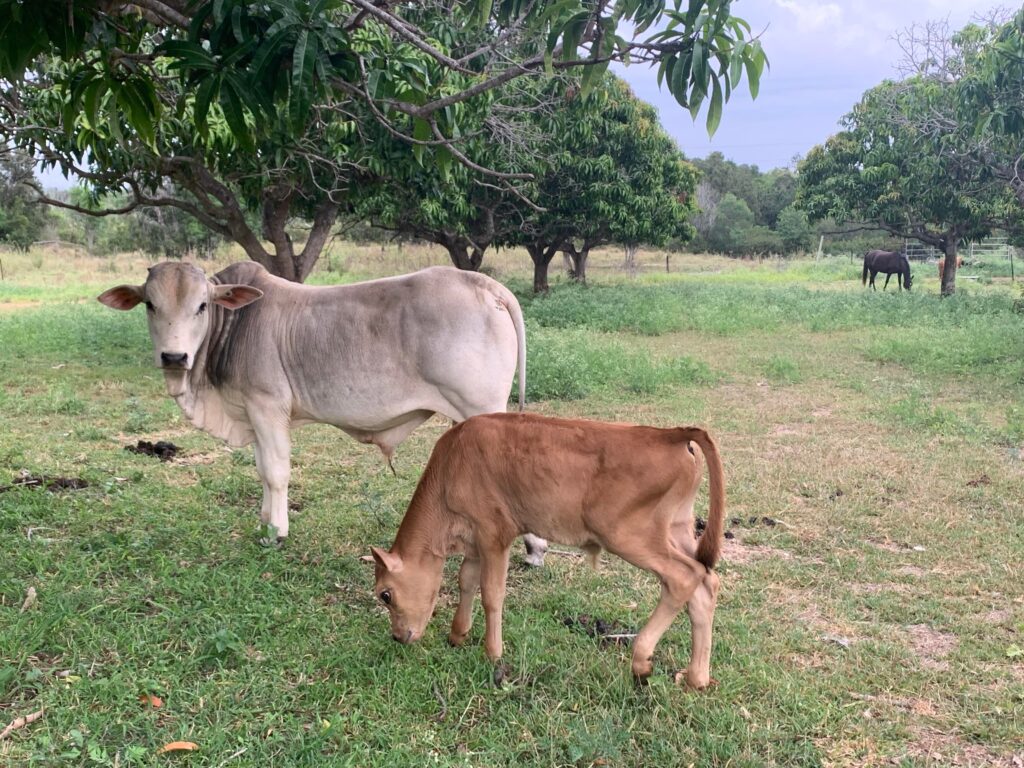
Zone 4
This is an area that needs far less management. It may consist of woodlots, native support species, mushrooms, foraging, habitat restoration, educational walks, or hunting. This is visited a few times per season, depending on the hunt or yield potential. There is ample opportunity to use this as an educational site, allowing people to interact with the space and learn from the ‘rewilding’.
By grazing your livestock in this area you can also help to feed them at a lower cost to you. This can be done by using mobile electric fencing and moving the animals along periodically. It’s a great way to maintain areas that are overgrown or need intervention for fire management. There are also some people who are able to offset their own expenses by renting their goats out!
Zone 5
This is an area for observation. Taking walks, meditating, reflecting, and appreciating. There’s very little management in this area, with the exception of disease or fire prevention when needed. The most you take away from this space is knowledge, ideas, and experience. When we understand what the natural system is doing, we are better equipped to mimic that behavior in our managed systems.
Permaculture Boundaries
Sometimes things won’t fit perfectly into the permaculture zone. That’s ok! There are times when it makes sense to have elements share the edge. There are also times when there may be more than one Zone 0, 3, or 5. It all depends on what the needs are for the site.
Permaculture properties are planned by breaking the property into zones. Things that have regular use or require regular service should be conveniently located in zone 0… or the source. It’s all about being conservative and conscious of energy and resources! Watch this video tour of Melliodora to see how David Holmgren and Sue Dennett have planned their property:

